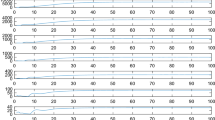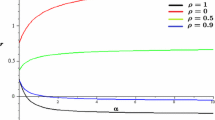Abstract
Ecologists have recently used integral projection models (IPMs) to study fish and other animals which continue to grow throughout their lives. Such animals cannot shrink, since they have bony skeletons; a mathematical consequence of this is that the kernel of the integral projection operator T is unbounded, and the operator is not compact. To our knowledge, all theoretical work done on IPMs has assumed the operator is compact, and in particular has a bounded kernel. A priori, it is unclear whether these IPMs have an asymptotic growth rate \(\lambda \), or a stable-stage distribution \(\psi \). In the case of a compact operator, these quantities are its spectral radius and the associated eigenvector, respectively. Under biologically reasonable assumptions, we prove that the non-compact operators in these IPMs share some important traits with their compact counterparts: the operator T has a unique positive eigenvector \(\psi \) corresponding to its spectral radius \(\lambda \), this \(\lambda \) is strictly greater than the supremum of the modulus of all other spectral values, and for any nonnegative initial population \(\varphi _0\), there is a \(c>0\) such that \(T^n\varphi _0/\lambda ^n \rightarrow c \cdot \psi \).

Similar content being viewed by others
References
Aalto E, Micheli F, Boch C, Montes JE, Wilson C, De Leo G (2019) Catastrophic mortality, Allee effects, and marine protected areas. Am Nat 193(3):391–408
Akhmerov R, Kamenskii M, Potapov A, Rodkina A, Sadovskii B (1992) Measures of noncompactness and condensing operators. Birkhäuser Verlag, Boston (translated from the Russian by A. Iacob)
Anselone P, Lee JW (1974) Spectral properties of integral operators with nonnegative kernels. Linear Algebra Appl 9:67–87
Bonsall F (1958) Linear operators in complete positive cones. Proc Lond Math Soc 3(9):54–75
Briggs J, Dabbs K, Holm M, Lubben J, Rebarber R, Tenhumberg B (2010) Structured population dynamics: an introduction to integral modeling. Math Mag 83:243–257
Browder F (1961) On the spectral theory of elliptic differential operators. Math Ann 142:22–130
Bruno J, Ellner S, Vu I, Kim K, Harvell C (2011) Impacts of aspergillosis on sea fan coral demography: modeling a moving target. Ecol Monogr 81(1):123–139
Caswell H (2001) Matrix population models: construction, analysis, and interpretation, 2nd edn. Sinauer Associates, Inc, Sunderland
Childs D, Rees M, Rose K, Grubb P, Ellner S (2003) Evolution of complex flowering strategies: an age- and size-structured integral projection model. Proc R Soc B Biol Sci 270:1829–1838
Childs D, Coulson T, Pemberton J, Clutton-Brock T, Rees M (2011) Predicting trait values and measuring selection in complex life-histories: reproductive allocation decisions in Soay sheep. Ecol Lett 10:985–992
Clément P, Heijmans H, Angenent S, van Duijn C, de Pagter B (1987) One-parameter semigroups. Elsevier, Amsterdam
Conway JB (1994) A course in functional analysis, 2nd edn. Springer, New York
Coulson T, MacNulty D, Stahler D, vonHoldt B, Wayne R, Smith D (2011) Modeling effects of environmental change on wolf populations dynamics, trait evolution, and life history. Science 334:1275–1278
Dunford N, Schwartz J (1958) Linear operators, part I: general theory. Interscience, New York
Eager E, Haridas C, Pilson D, Rebarber R, Tenhumberg B (2013) Disturbance frequency and vertical distribution of seeds affect long-term population dynamics: a mechanistic seed bank model. Am Nat 182(2):180–190
Easterling M (1998) The integral projection model: theory, analysis, and application. Ph.D. thesis, North Carolina State University
Edmunds D, Evans W (1987) Spectral theory and differential operators. Oxford University Press, New York
Edmunds D, Potter A, Stuart C (1972) Non-compact positive operators. Proc R Soc Ser A Math Phys Sci 328(1572):67–81
Ellner S, Rees M (2006) Integral projection models for species with complex demography. Am Nat 167(3):410–428
Ellner S, Childs D, Rees M (2016) Data-driven modelling of structured populations: a practical guide to the integral projection model. Springer, Cham
Hegland S, Jongejans E, Rydgren K (2010) Investigating the interaction between ungulate grazing and resource effects on Vaccinium myrtillus populations with integral projection models. Oecologia 163(3):695–706
Jacquemyn H, Brys R, Jongejans E (2010) Size-dependent flowering and costs of reproduction affect population dynamics in a tuberous perennial woodland orchid. J Ecol 98:1204–1215
Karlin S (1959) Positive operators. J Math Mech 8(6):907–937
Krasnosel’skij M, Lifshits J, Sobolev A (1989) Positive linear systems: the method of positive operators. Heldermann Verlag, Berlin (translated from the Russian by Jürgen Appell)
Krein M, Rutman M (1950) Linear operators leaving invariant a cone in a Banach space. Am Math Soc Transl Ser 1(10):199–325
Lemmens B, Nussbaum R (2013) Continuity of the cone spectral radius. Proc Am Math Soc 141(8):2741–2754
Lubben J, Boeckner D, Rebarber R, Townley S, Tenhumberg B (2009) Parameterizing the growth-decline boundary for uncertain population projection models. Theor Popul Biol 75:85–97
Mallet-Paret J, Nussbaum R (2002) Eigenvalues for a class of homogeneous cone maps arising from max-plus operators. Discrete Contin Dyn Syst 8(3):519–562
Marek I (1967) \(u_0\)-positive operators and some of their applications. SIAM J Appl Math 15(3):484–494
Marek I (1970) Frobenius theory of positive operators: comparison theorems and applications. SIAM J Appl Math 19(3):607–628
Miller T, Williams J, Jongejans E, Brys R, Jacquemyn H (2012) Evolutionary demography of iteroparous plants: incorporating non-lethal costs of reproduction into integral projection models. Proc R Soc B Biol Sci 279(1739):2831–2840
Niiro F, Sawashima I (1966a) On positive irreducible operators in an arbitrary Banach lattice and a problem of H. H. Schaefer. Proc Jpn Acad 42(7):677–681
Niiro F, Sawashima I (1966b) On the spectral properties of positive irreducible operators in an arbitrary Banach lattice and problems of H. H. Shaefer. Sci Pap Coll Gen Educ Univ Tokyo 15:145–183
Nussbaum R (1970) The radius of the essential spectrum. Duke Math J 38:473–478
Ohlberger J, Langangen Ø, Winfield I, Vindenes Y (2020) The importance of variation in offspring body size for stability in cannibalistic populations. Oikos 129:59–69
Raghavan T (1965) On linear operators leaving a convex set invariant in Banach spaces. Indian J Stat 10(2):293–302
Rees M, Rose K (2002) Evolution of flowering strategies in Oenothera glazioviana: an integral projection model approach. Proc R Soc B Biol Sci 269(1499):1509–1515
Rudin W (1976) Principles of mathematical analysis, 3rd edn. McGraw Hill, New York
Rudin W (1987) Real and complex analysis, 3rd edn. McGraw-Hill, New York
Sawashima I (1964) On spectral properties of some positive operators. Nat Sci Rep Ochanomizu Univ 15(2):53–64
Schaefer H (1960) Some properties of positive linear operators. Pac J Math 10:1009–1019
Stubberud M, Vindenes Y, Vøllestad L, Winfield I, Stenseth N, Langangen Ø (2019) Effects of size- and sex-selective harvesting: an integral projection model approach. Ecol Evol 9(22):12556–12570
Tenhumberg B, Suwa T, Tyre A, Russell L, Louda S (2015) Integral projection models show exotic thistle is more limited than native thistle by ambient competition and herbivory. Ecosphere 6(4):1–18
Vindenes Y, Langangen Ø (2015) Individual heterogeneity in life histories and eco-evolutionary dynamics. Ecol Lett 18:417–432
Vindenes Y, Edeline E, Ohlberger J, Langangen Ø, Winfield I, Stenseth N, Vøllestad L (2014) Effects of climate change on trait-based dynamics of a top predator in freshwater ecosystems. Am Nat 183(2):243–256
Acknowledgements
Richard Rebarber and Matt Reichenbach were partially supported by National Science Foundation Division of Mathematical Sciences Grant 141259. Brigitte Tenhumberg was supported by USDA–NIFA Grant 2017-03807, and the U.S. National Science Foundation (DEB 1655117). We would like to thank an anonymous reviewer, whose suggestions and constructive comments have greatly improved the quality of this paper.
Author information
Authors and Affiliations
Corresponding author
Additional information
Publisher's Note
Springer Nature remains neutral with regard to jurisdictional claims in published maps and institutional affiliations.
Rights and permissions
About this article
Cite this article
Reichenbach, M., Rebarber, R. & Tenhumberg, B. Spectral properties of a non-compact operator in ecology. J. Math. Biol. 82, 50 (2021). https://doi.org/10.1007/s00285-021-01600-7
Received:
Revised:
Accepted:
Published:
DOI: https://doi.org/10.1007/s00285-021-01600-7
Keywords
- Population dynamics
- Indeterminate growth
- Integral projection models
- Positive operators
- Essential spectrum
- Perron–Frobenius theorem
- Measures of non-compactness




